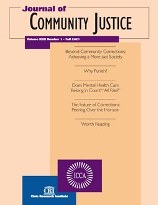Guilt Versus Shame: Building a Positive Self-Identity in Those With Sexual Offenses
Author: Randy Shively.
Source: Volume 28, Number 02, Winter 2019 , pp.5-8(4)

< previous article |next article > |return to table of contents
Abstract:
This article discusses the importance for correctional professionals working with those who commit sexual crimes to separate the offender from their crime and help them to see their offense as bad, rather than themselves as irredeemable. Toxic shame is discussed in relation to negative self-identity, a lack of responsibility, blaming the victim, and mismanaging anger. Redemptive guilt is discussed as helping offenders focus on their past crime/behavior as bad, while developing some hope in their present self/life. The strength-based, future-oriented, and goal-directed Good Lives Model offers hope to the inmate and needed training for correctional staff. Sexual offenders learn to develop life goals and objectives with respect to primary goods such as healthy living, excellence in work, happiness, inner peace, and creativity. Goal completion develops hope, improved self-identity, reduction of shame, and a process to cope with the guilt related to their offense(s).Keywords: Community corrections, sexual offenders, toxic shame, Good Lives Model, redemptive guilt
Affiliations:
1: Alvis.